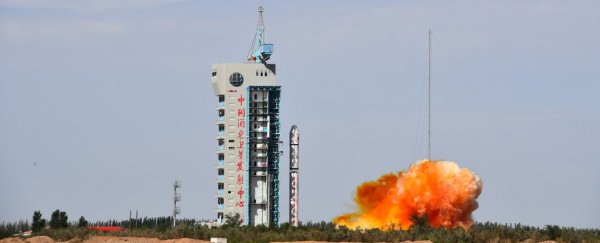The Chinese government has announced a first – they have successfully landed a reusable spacecraft safely back on Earth after it spent two days in orbit.
The spacecraft – called Chongfu Shiyong Shiyan Hangtian Qi (CSSHQ) - was launched September 4 on a Long March-2F carrier from the Jiuquan Satellite Launch Centre in northwest China.
It was in orbit for two days (although we're not sure what it was doing up there) and then returned to Jiuquan on Sunday as scheduled, according to state run media.
The government run news agency Xinhua has released few other details about this secretive Chinese military program.
If all this pans out, CSSHQ will be China's first reusable spacecraft - quite a feat considering only a handful of companies have produced reusable spaceplanes, first stages, and crew capsules – most of which have been American.
Considering a single rocket launch can cost tens of millions of dollars, reusable parts are intended to allow companies – or in this case countries – to potentially lower the cost of a launch.
It's important to note though, that despite best intentions, reusability of spacecraft and their parts doesn't necessarily mean they end up costing less. NASA's Space Shuttle was the first partially reusable launch vehicle, but it failed to make the launch process any cheaper than expendable launch systems.
Long March-2F (or 'Shenjian' meaning Divine Arrow) was the non-reusable rocket used to launch CSSHQ into orbit. China has now used this design to launch 14 missions since 1999, and to launch crewed missions since 2003.
Unfortunately, we have very little information about the reusable spacecraft, and media is yet to release any photos of the landing.
Some reports have suggested CSSHQ is a spaceplane, but that's yet to be confirmed.
At the Jiuquan cosmodrome in northwestern China, preparations are underway for the launch of the Long March 2F rocket. Perhaps a prototype of a reusable spacecraft, an analogue of the Boeing X-37(OTV) or Space Rider, will be tested. #China #Asia #Space #news #rocket pic.twitter.com/0ljOduTChG
— Smith Gaski (@Smit_Gaski) March 4, 2020
Hopefully we'll find out more information soon.
"The successful flight marked the country's important breakthrough in reusable spacecraft research," Xinhua writes, "and is expected to offer convenient and low-cost round trip transport for the peaceful use of the space."
